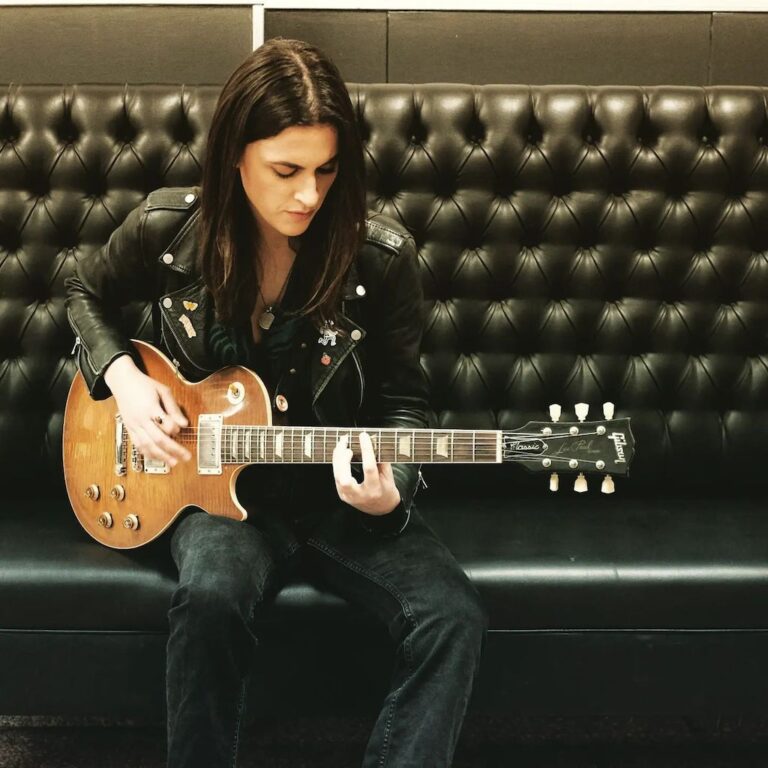French Accordion: The Soul of French Music
Discover the magic of the instrument that defines the sonic identity of France
The French Accordion: Living Cultural Heritage
The French accordion represents much more than a simple musical instrument; it is the vibrant voice of French culture and the sonic heart of the popular traditions that have shaped the country’s musical identity for more than two centuries. This wind and keyboard instrument, with its characteristic musette sound, instantly transports you to Parisian alleyways, bohemian cafés, and rural celebrations that define the essence of France.
From the banks of the Seine to the most remote corners of the French countryside, the accordion has been witness to and protagonist of crucial historical moments, evolving from a humble immigrant instrument to become a national symbol. Its technical versatility allows for the interpretation of everything from melancholy ballads to festive musette waltzes that inevitably invite dancing.
Today, far from being a relic of the past, the French accordion is experiencing a significant renaissance, merging with contemporary genres and winning over new generations of musicians and fans. Traditional manufacturers maintain century-old artisanal techniques while incorporating innovations that expand the expressive possibilities of this unique instrument, ensuring that the distinctive sound of the French accordion continues to be an integral part of the global musical landscape.
“The French accordion is not just an instrument, it’s a bridge between generations, a guardian of traditions and a cultural ambassador that transcends borders.” — Jean-Michel Accordéon, musicologist
In this definitive guide, we will thoroughly explore all the aspects that make the French accordion an unparalleled instrument: its fascinating history, distinctive technical characteristics, emblematic musical styles, legendary performers who defined its sound, and the manufacturers who keep this unique cultural heritage alive.
History of the French Accordion
Origins in the 19th century
The accordion arrived in France around 1830, a few years after its invention in Vienna by Cyrill Demian. What began as a simple button instrument would rapidly evolve on French soil. Unlike other European countries, France developed a unique relationship with the accordion, transforming it to meet the specific needs of its musical traditions.
Evolution through the decades
Between 1880 and 1900, the accordion underwent significant transformations in France. The first “chromatic accordions” were developed, allowing for greater melodic complexity. The most revolutionary innovation was the introduction of the “musette” system – the tuning of multiple reeds slightly detuned from each other to create a vibrant and distinctive timbre that would define the French sound.
1880-1900
Emergence of the first specialized workshops in Paris that experimented with new configurations.
1920-1940
Golden age of the French accordion with the popularization of musette dances and the proliferation of cafés-concert.
1950-Present
Preservation of traditional techniques alongside electronic innovations and fusions with other musical genres.
Impact on French popular music
The accordion became a symbol of French musical identity, especially during the Belle Époque and the interwar period. Cafés-concert and popular dances adopted it as the main instrument. During the German occupation in World War II, the accordion acquired additional significance as a symbol of cultural resistance, preserving French identity through its characteristic music.
The impact of the French accordion transcended national borders, influencing musical styles throughout Europe and reaching as far as America. Today, it continues to be an essential element in traditional French music and a globally recognized cultural symbol.
Technical Characteristics and Sound
Unique design of the French accordion
The French accordion is distinguished by specific characteristics that differentiate it from other types. It typically features a chromatic system on the right keyboard, with buttons arranged in parallel rows following the “French System” (also known as “B-Button System”). The internal mechanism is designed to favor fast response and precise articulation, perfect for the ornaments and embellishments characteristic of French music.
Keyboard and Buttons
- Chromatic button system with unique distribution
- From 3 to 5 rows on the right keyboard
- “Stradella” bass system modified for French music
- Multiple registers for timbral variation
Construction and Materials
- Select woods for the case (maple, walnut, mahogany)
- Internal mechanism optimized for quick response
- Bellows with reinforced pleats for greater durability
- Decorative finishes with mother-of-pearl and marquetry
Differences from other types of accordions
Unlike Italian or German accordions, the French one prioritizes a more pronounced and defined attack, ideal for the precise articulation required by traditional French repertoire. The button distribution follows its own pattern that facilitates certain harmonic progressions common in French music. The instrument’s weight and balance are also optimized for playing while standing for long periods, as is traditional in popular dances.
| Characteristic | French Accordion | Italian Accordion | German Accordion |
|---|---|---|---|
| Tuning | Musette (multiple detuned reeds) | Dry and precise | Balanced and dark |
| Button system | French System (B-griff) | C-griff System | German System |
| Timbral emphasis | Bright and vibrant | Balanced and versatile | Round and deep |
The characteristic “musette” sound
The “musette” sound is the hallmark of the French accordion. It is achieved through the specific tuning of multiple reeds for the same note, creating a characteristic vibrato effect. Traditionally, three sets of reeds are used: one tuned to the exact tone, another slightly sharp, and the third slightly flat. This combination produces the undulating and expressive timbre that instantly evokes the atmosphere of Paris.
The French accordion is distinguished not only by its unique sound but also by the deep emotional connection it establishes with those who hear it. Its timbre immediately evokes the streets of Montmartre, the bohemian cafés of the Seine, and the great popular celebrations that have defined French social life for generations.
Are accordions originally French?
Origin of the accordion: An Austrian instrument with a French soul
Contrary to popular belief, the accordion was not invented in France. The first officially patented accordion was created by the Viennese manufacturer Cyrill Demian in 1829 in Austria. The original patent described a small instrument with 5 keys and no bass keyboard.
Although accordions are not originally French, France played a crucial role in the evolution, refinement, and worldwide popularization of this instrument. This perception is so ingrained that many people incorrectly assume that the accordion was born on the streets of Paris.
The French transformation of the accordion
Early adoption in France
Paris quickly became a center for accordion manufacturing in the 1830s, barely a year after the original patent. The French manufacturer M. Pichenot published the first teaching method for accordion in 1831, and the city filled with artisanal workshops that began to innovate in the design.
Key French innovations
French manufacturers transformed the rudimentary Viennese accordion by introducing crucial improvements: complete chromatic system, Stradella basses, multiple voice registers, and, perhaps most importantly, the “musette” tuning that created the characteristic French sound that popularized the instrument worldwide.
Perception vs. historical reality
The association between France and the accordion is so strong that it has eclipsed the true origins of the instrument. This cultural connection is due to several historical factors:
| Myth | Reality |
|---|---|
| The accordion was invented in France | It was patented in 1829 in Vienna (Austria) by Cyrill Demian |
| The musette style is the original accordion | It is a later French innovation (circa 1880) that modified the original instrument |
| The accordion was always popular in France | At first it was considered an instrument for the lower classes, only gaining widespread acceptance after the Belle Époque |
Cultural identity
During the Belle Époque and the interwar period, the accordion became a symbol of French resistance and spirit, especially during the German occupation in World War II.
Media representation
Cinema, postcards, and literature have reinforced the image of the Parisian accordionist, to the point of becoming an international stereotype of French culture.
Continuous innovation
The French never stopped perfecting the instrument, establishing manufacturing schools and performance styles that remain a global reference.
While accordions are not originally French, it is undeniable that France adopted this instrument as its own, transforming it and elevating it to a national cultural symbol. Thanks to French innovations, especially the musette tuning and popular dances, the accordion was able to transcend its humble Austrian origins to become a musical ambassador of France recognized throughout the world.
Accordion in French: Terminology and Vocabulary
How to say accordion in French: “accordéon”
Pronunciation:
Accordéon [a.kɔʁ.de.ɔ̃] – The correct pronunciation emphasizes the last syllable with a nasal sound characteristic of French.
Common expressions
- Jouer de l’accordéon – To play the accordion
- Un accordéoniste – An accordionist
- Un bal musette – A traditional accordion dance
- Faire l’accordéon – A figurative expression meaning “to contract and expand” (like an accordion)
- Effet d’accordéon – Accordion effect (term used in vehicular traffic)
Types of accordions in French
- Accordéon diatonique – Diatonic accordion
- Accordéon chromatique – Chromatic accordion
- Accordéon à touches piano – Piano keyboard accordion
- Accordéon à boutons – Button accordion
- Accordéon musette – Accordion with typical French musette tuning
Technical glossary for accordionists
| French term | Pronunciation | Meaning in English |
|---|---|---|
| Le soufflet | [lə su.flɛ] | The bellows |
| Les anches | [le zɑ̃ʃ] | The reeds |
| Le clavier main droite | [lə kla.vje mɛ̃ dʁwat] | Right hand keyboard |
| La basse | [la bas] | The bass |
| Les registres | [le ʁe.ʒistʁ] | The registers |
| L’accord | [la.kɔʁ] | The tuning/chord |
| La bretelle | [la bʁə.tɛl] | The strap |
| Le caisson | [lə kɛ.sɔ̃] | The case |
Music and its genres
La valse musette
The musette waltz, an emblematic genre of the French accordion, performed in 3/4 time with a cheerful tempo.
La java
Popular dance derived from the waltz but with a more syncopated rhythm, very common in Parisian cabarets.
Le quadrille
Dance for four couples in square formation, adapted to the French accordion style.
Useful phrases for accordionists in France
- Où puis-je acheter des anches pour mon accordéon?
Where can I buy reeds for my accordion? - Je cherche un accordéon à trois voix avec accord musette.
I’m looking for a three-voice accordion with musette tuning. - Pouvez-vous régler les basses de mon accordéon?
Can you adjust the basses of my accordion? - Je voudrais prendre des cours d’accordéon musette.
I would like to take musette accordion lessons. - Connaissez-vous des partitions de valses musette traditionnelles?
Do you know any traditional musette waltz sheet music?
Knowing the terminology of the accordion in French not only enriches the learning experience of the instrument but also connects the musician with the rich French accordion tradition. Mastering this vocabulary is especially valuable for those seeking to delve into styles such as musette or planning to visit France to study or acquire an authentic instrument from traditional French manufacturers.
Musical Styles and Genres
Traditional musette music
The term “musette” originally referred to a French bagpipe, but since the late 19th century, it has been associated with the musical style defined by the accordion. Musette music was born in the working-class neighborhoods of Paris, especially in Belleville and Ménilmontant, where Italian and Auvergne immigrants mixed their musical traditions. This genre is characterized by expressive melodies, marked rhythm, and a balanced combination of melancholy and festive joy.
Origins of Musette
It emerged in Paris cafés and cabarets in the late 19th century, fusing musical traditions of Italian and Auvergne immigrants with Parisian culture. The accordion gradually replaced the musette (bagpipe) as the main instrument, defining the characteristic sound of this genre.
Typical Instrumentation
The traditional musette orchestra included accordion as the central instrument, accompanied by banjo, guitar, double bass, and occasionally drums. This instrumentation created a distinctive sound that allowed for both intimate café performances and lively popular dances.
Vals-musette and popular dances
The vals-musette is perhaps the most emblematic form of French accordion music. An adaptation of the Viennese waltz, it is distinguished by a slightly faster tempo and a more cheerful and popular character. Vals-musette dances became central social events in Parisian life, especially among the working classes, in the famous “bals-musette” that flourished between 1880 and 1950.
The accordion in French chanson
Beyond purely instrumental music, the French accordion became an essential element of the French chanson. Legendary artists such as Édith Piaf, Charles Trenet, and Jacques Brel regularly incorporated the accordion in their recordings, solidifying the association between this instrument and French cultural identity. The accordion provided the emotional color necessary for the themes of love, nostalgia, and everyday life that characterized these songs.
Java
Popular dance in 3/4 time with a characteristic rhythm and undulating movement.
Tango Musette
Fusion of Argentine tango with French sensibility and ornamentation.
Bal Musette
Social events where the accordion was the protagonist in animating popular dances.
In recent decades, the French accordion has found new expressions in fusions with jazz, rock, and electronic music. Contemporary artists such as Richard Galliano have elevated the instrument to new contexts without losing the essence of the traditional French sound. This continuing evolution demonstrates the vitality and perennial relevance of the accordion in the French music scene.
The French accordion not only defines specific musical genres but represents a bridge between tradition and innovation in European music. Its ability to evolve while maintaining its distinctive sonic identity makes it a fascinating case study of cultural resilience in a globalized musical world.
Legendary Accordionists
The tradition of the French accordion has been shaped by virtuoso performers who defined styles, innovated technically, and elevated the instrument to extraordinary artistic levels. These masters not only mastered the instrument but created stylistic schools that continue to influence new generations today.
Jo Privat (1919-1996)
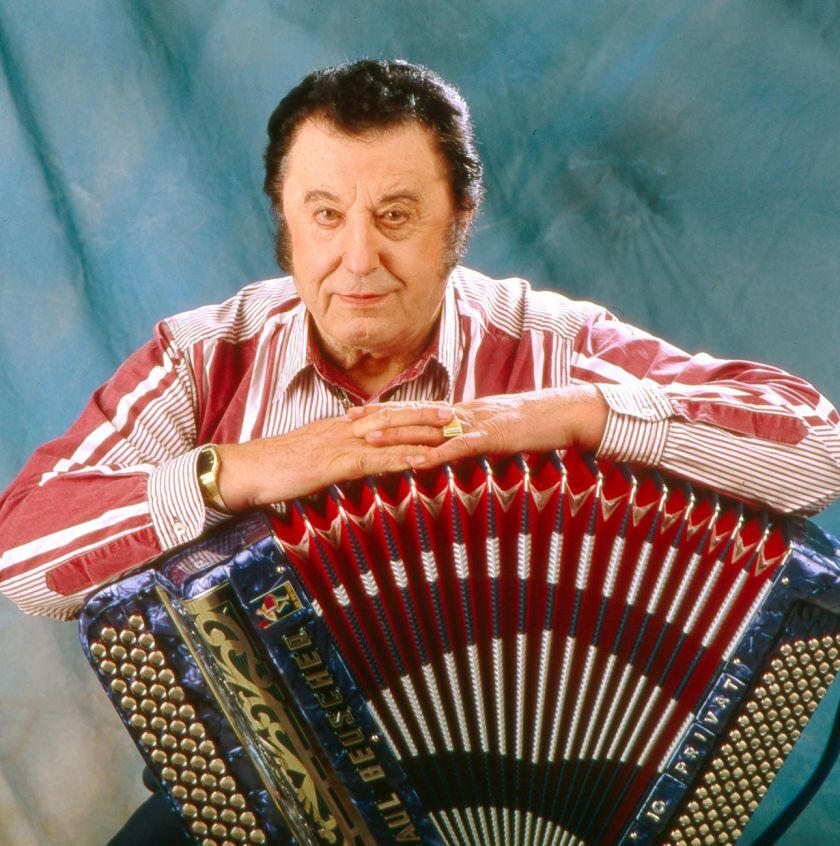
Jo Privat is considered one of the greatest exponents of the vals-musette. Emerging from the Parisian cabaret scene, he developed a style characterized by impeccable technique and an unmistakable expressive phrasing.
Privat is especially recognized for his series of recordings “Bals à Jo”. His influence extends beyond France.
Gus Viseur (1915-1974)
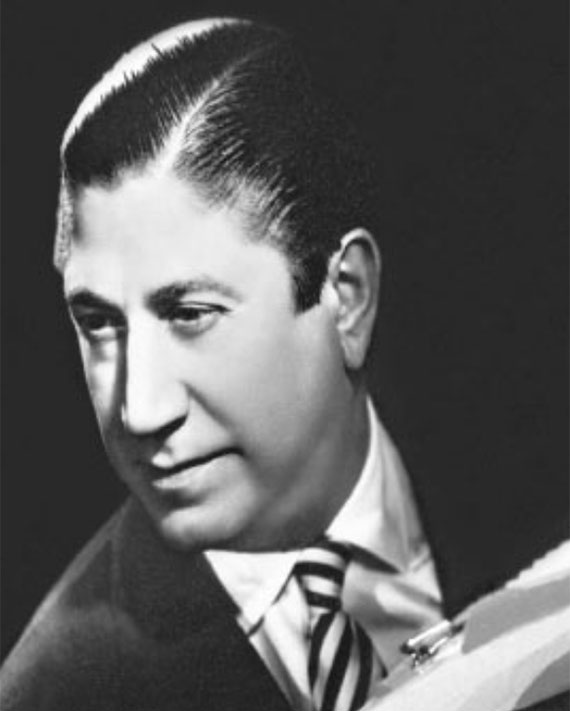
A pioneer in the fusion of musette accordion with manouche jazz (gypsy jazz), Gus Viseur frequently collaborated with Django Reinhardt.
His style incorporated harmonic complexities from jazz while maintaining the essence of traditional musette sound.
Marcel Azzola (1927-2019)

Marcel Azzola represents the bridge between the musette tradition and the concert accordion. He was prominent alongside figures like Jacques Brel and Édith Piaf.
Azzola elevated the status of the accordion to the realm of classical music.
Richard Galliano (1950-present)
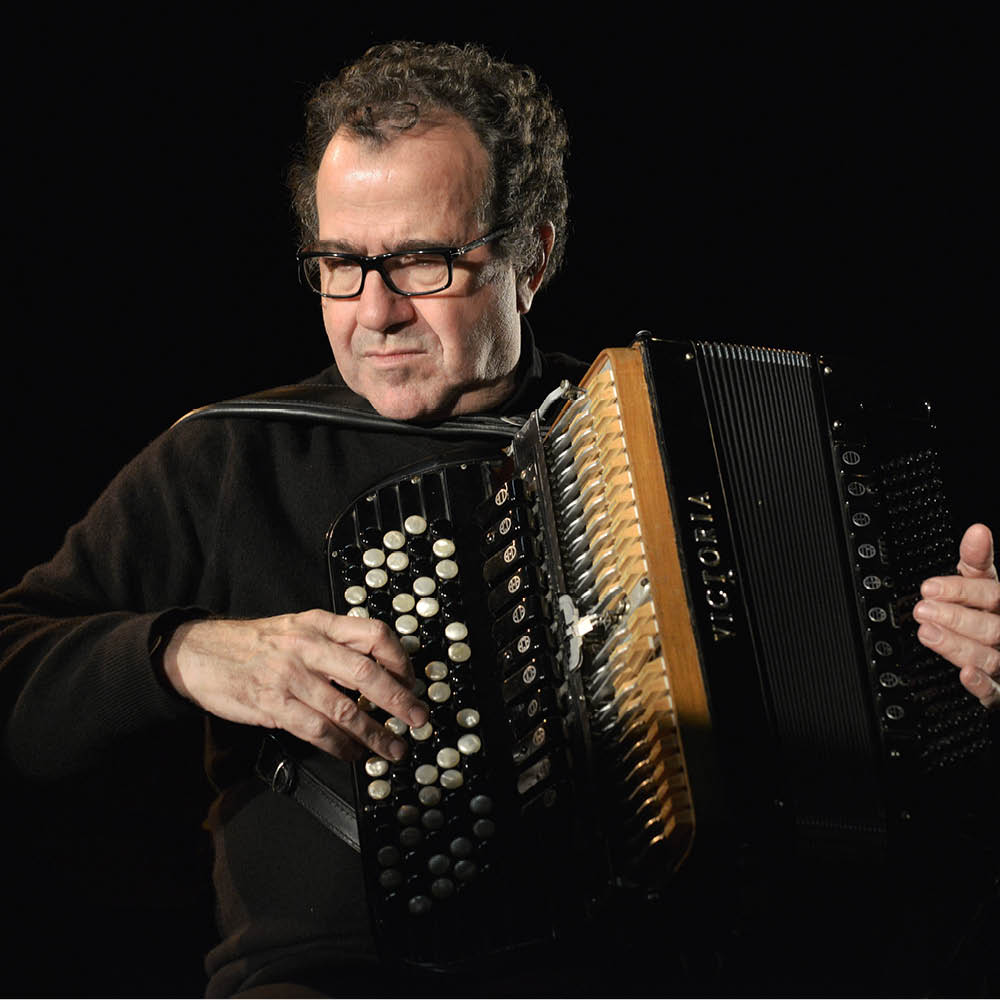
Richard Galliano has revolutionized the accordion by creating the “New Musette,” a fusion between French tradition and contemporary jazz.
Galliano has worked with international artists such as Chet Baker and Wynton Marsalis.
These masters of the French accordion represent different eras and styles, but they share a deep respect for tradition and innovation that keeps this instrument alive in global culture.
Main French Manufacturers
France has a centuries-old tradition in accordion manufacturing, with artisan workshops that have passed down knowledge from generation to generation. These manufacturers have developed distinctive characteristics that define the sound and aesthetics of the French accordion.
Cavagnolo
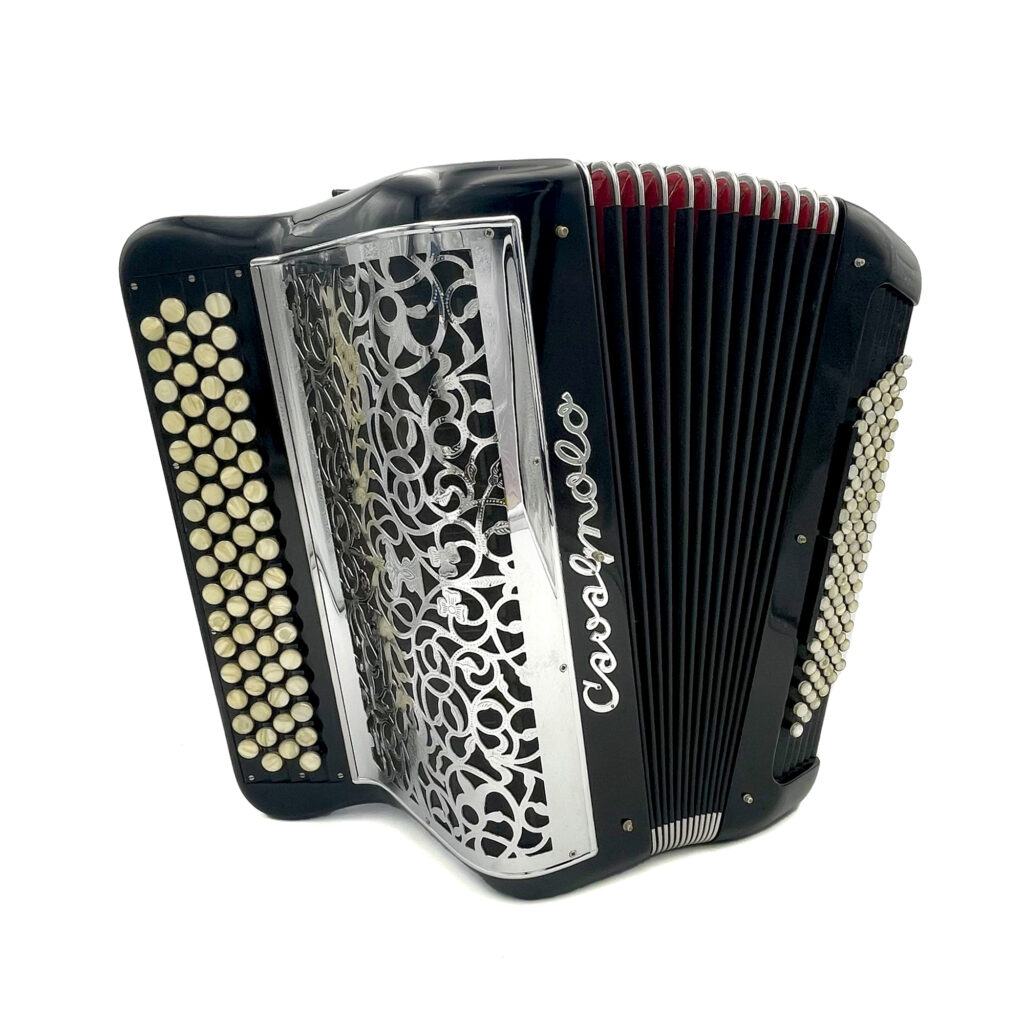
Distinctive characteristics:
- Powerful and expressive sound with pronounced musette tuning
- Quick response mechanism especially valued by musette performers
- Elegant decorative finishes with high-quality materials
- Ergonomic keyboard adapted to French technique
Iconic models:
The “Cavagnolo Vedette” and the “Cavagnolo Super Musette” are considered benchmarks in authentic musette sound.
Maugein
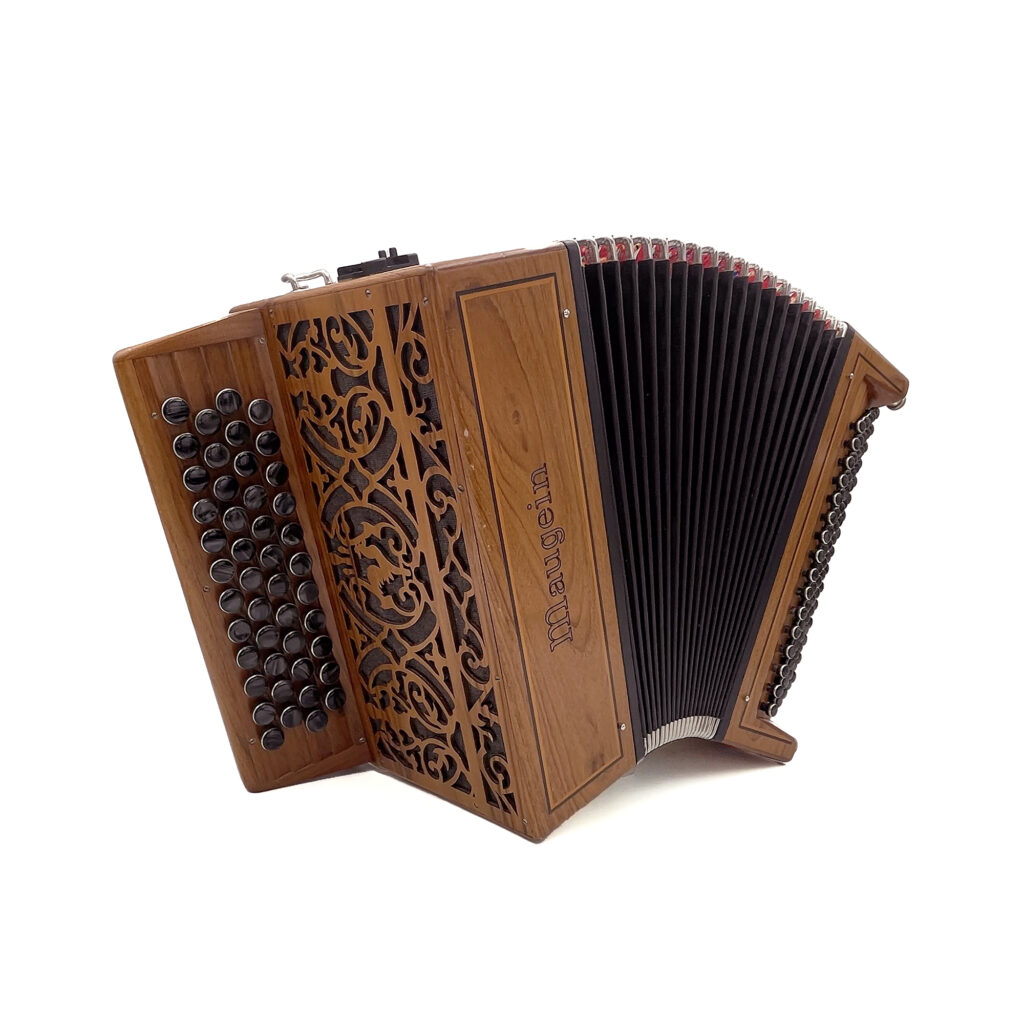
Distinctive characteristics:
- Oldest manufacturer in France (founded in 1919 in Tulle)
- Refined tonal balance with controlled musette tuning
- Robust construction with selected French woods
- Preferred for performance of traditional Auvergne repertoire
Iconic models:
The “Maugein Neva” has become a classic, and the “Centenaire” line celebrates a century of artisanal manufacturing.
Saltarelle
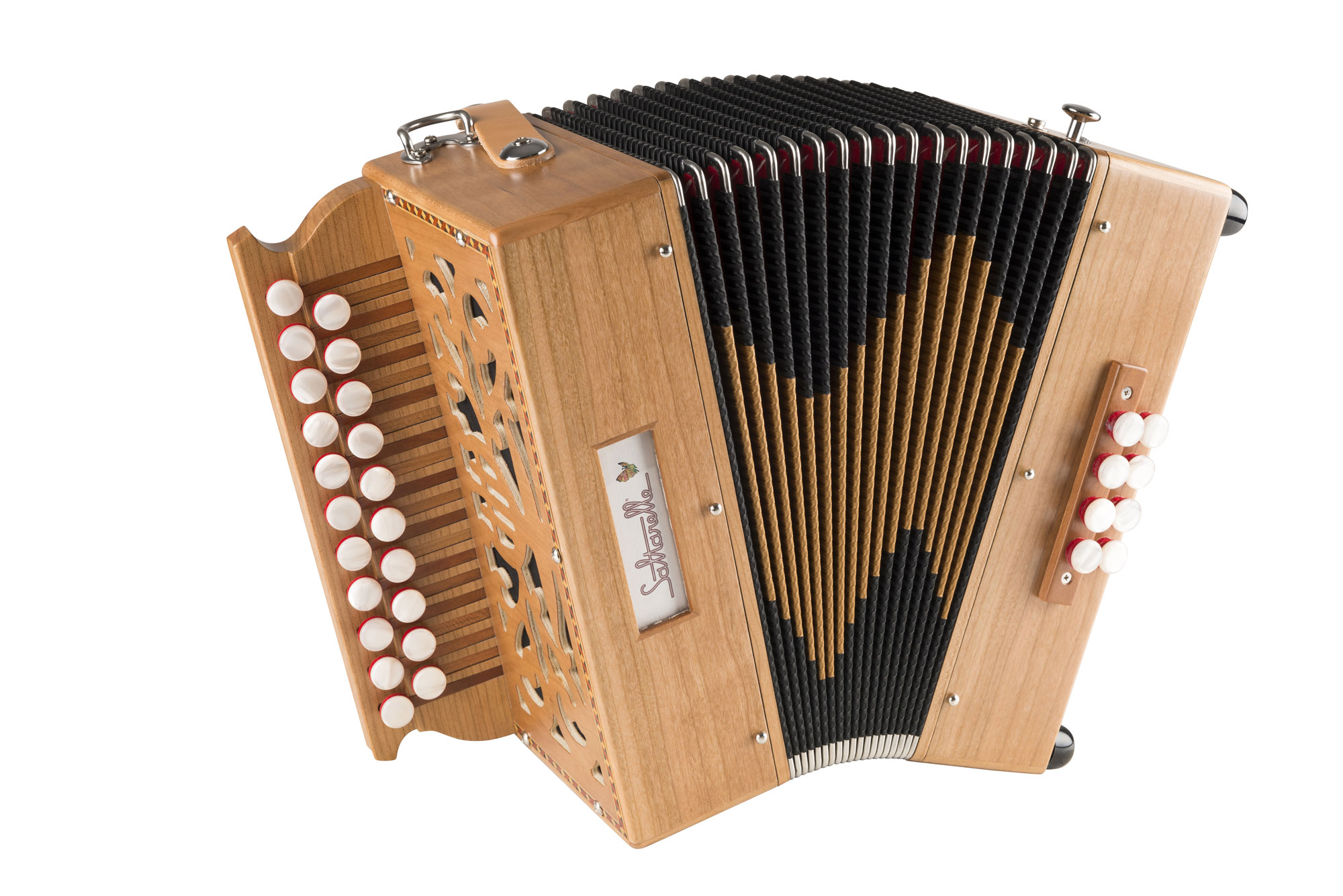
Distinctive characteristics:
- Technical innovation combined with respect for tradition
- Specialists in lightweight diatonic and chromatic accordions
- Modular construction that allows for customization
- Bright sound with excellent projection
Iconic models:
The “Saltarelle Nuage” revolutionized the design of diatonic accordions, and the “Pastourelle” series is a professional reference.
Bertrand Gaillard
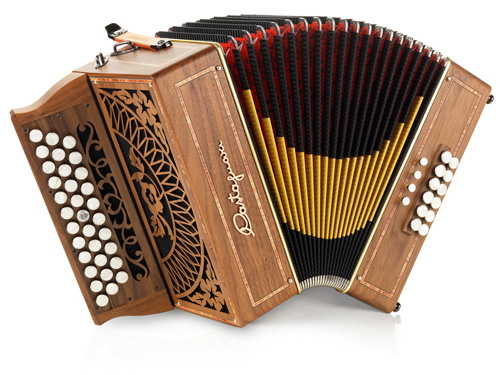
Distinctive characteristics:
- High-precision artisanal manufacturing
- Focus on acoustics and dynamic response
- Innovative designs respecting traditional aesthetics
- Lightweight instruments with great sound power
Iconic models:
The “Gaillard Saphir” is highly valued for its balance between tradition and innovation.
Traditional manufacturing process
The manufacturing of a traditional French accordion involves more than 300 hours of artisanal work, starting with the selection of woods that are naturally dried for years.
French accordion manufacturers combine centuries-old traditions with modern innovations to create instruments that satisfy both traditional performers and contemporary musicians.
Discover the Best Accordions on Amazon
We carefully select the highest quality accordions and accessories available on Amazon so you can begin or continue your musical journey with the French accordion. All these products have been evaluated for their quality, price-performance ratio, and sonic authenticity.
Frequently Asked Questions about the French Accordion
We answer the most common questions about the French accordion, its history, characteristics, and curiosities to help you better understand this emblematic instrument.
The accordion gained popularity in France due to a combination of historical and cultural factors:
- In the 1880s, it coincided with the migration of Auvergne and Italian workers to Paris, who brought their musical traditions.
- The rise of cafés-concert and popular dances (bal-musette) created ideal spaces for accordion music.
- During the Belle Époque, the accordion became a symbol of Parisian bohemian culture.
- In difficult periods such as the world wars, its portability and ability to liven up parties made it an instrument of cultural resistance.
Additionally, French innovations, especially the “musette” tuning, created a distinctive sound that was internationally identified with French identity, reinforced through cinema, chanson, and cultural representations.
The French accordion differs from other models in several key aspects:
| Characteristic | French Accordion | Other Accordions |
|---|---|---|
| Tuning | Musette tuning with multiple reeds slightly detuned to create a vibrato effect | Dry tuning (Italian) or wet tuning but less pronounced (Russian, German) |
| Button system | French B-griff system with 3-5 rows of buttons | C-griff system (Italian) or piano key system (American) |
| Response | Quick and articulated attack for ornamentation | Smoother and more sustained response (Italian or Russian variants) |
| Ergonomics | Designed to be played standing at popular dances | Varied according to purpose (concert, study, folklore) |
These differences have evolved to meet the specific needs of the French repertoire, particularly the vals-musette and other traditional dance styles.
The musette sound is the characteristic timbre of the French accordion, immediately recognizable by its vibrant and undulating quality that evokes the atmosphere of Parisian cafés.
How it is technically achieved:
- Multiple reeds per note: Each key or button activates 2-3 (sometimes up to 4) reeds for the same note.
- Deliberate detuning: These reeds are tuned slightly differently from each other:
- One reed at exact pitch
- One or two slightly above pitch (2-10 cents)
- Sometimes one slightly below pitch
- Degrees of intensity: There are different degrees of musette tuning:
- Light musette (soft tremolo)
- Medium musette (the most common)
- American musette (with more pronounced vibrato)
Technical fact: The musette effect is due to the beats that occur when two slightly detuned notes sound simultaneously, creating an undulating interference pattern that varies according to the degree of detuning.
This sound was developed to stand out in noisy environments such as cafés and popular dances, providing a penetrating and expressive timbre well suited to the emotional melodies of the French repertoire.
France has produced some of the most influential accordionists in the world, who defined different periods and styles:
Pioneers and Classical Era
- Émile Vacher (1883-1969) – Considered the founder of the modern musette style
- Charles Péguri (1879-1930) – Virtuoso who established fundamental techniques
- Médard Ferrero (1919-1987) – Master of technical precision
- André Verchuren (1920-2013) – “The king of the accordion,” sold millions of records
Golden Age of Musette
- Jo Privat (1919-1996) – Legendary performer of Parisian musette
- Gus Viseur (1915-1974) – Pioneer in merging musette with manouche jazz
- Tony Murena (1915-1971) – Composer of repertoire classics
- Marcel Azzola (1927-2019) – Frequent collaborator of Jacques Brel
Contemporary Innovators
- Richard Galliano (1950-present) – Creator of “New Musette,” fusion with contemporary jazz
- Marc Perrone (1951-present) – Renovator of the diatonic accordion
- Vincent Peirani (1980-present) – Innovator who fuses jazz, classical and contemporary music
- Felicien Brut (1986-present) – New generation combining classical and traditional repertoire
Each of these artists has contributed significantly to the evolution of the French accordion, from popular dances to international concert halls, demonstrating the versatility and expressive richness of the instrument.
Short answer:
No, the accordion is not originally French. It was invented in Vienna (Austria) in 1829 by Cyrill Demian.
Despite the strong cultural association between France and the accordion, the instrument has Austrian origins. What occurred was a remarkable French adoption and transformation that redefined the instrument:
Accordion timeline:
- 1829 Cyrill Demian patents the first “Akkordion” in Vienna, Austria
- 1831 The accordion arrives in Paris; M. Pichenot publishes the first teaching method
- 1880s Paris becomes a center of innovation, developing improved chromatic versions
- 1890-1910 Development of the musette tuning that defines the characteristic French sound
The cultural association between France and the accordion is so strong that it has eclipsed its true Austrian origin in popular perception. The French adopted, perfected, and popularized the instrument, turning it into a national symbol, but the accordion as a basic instrument was not born in France.
For more information on how France transformed the accordion, visit our section on the origin of the accordion and its French adoption.
Choosing your first French accordion can be decisive for your progress and motivation. Here are recommendations especially for those looking to start with the French style:
Key factors to consider:
-
Type of accordion: For French music, consider:
- Button chromatic accordion (French B system) – Ideal for musette music
- Piano-type keyboard accordion – More accessible for beginners with no previous experience
- Diatonic accordion – For traditional French regional music
- Size and weight: For beginners, a 72-96 bass model is usually appropriate. Consider a lighter instrument (4-7 kg) to facilitate extended practice sessions.
- Tuning: Look for a model with light or medium musette tuning, which offers the characteristic French sound without being too extreme for a beginner.
-
Budget:
- 500-800€: Basic student instruments
- 800-1500€: Good quality intermediate instruments
- 1500€+: Professional quality instruments
Recommended brands for beginners:
French Options:
- Cavagnolo (student models)
- Maugein (beginner series)
- Hohner (models manufactured in France)
Other Affordable Options:
- Weltmeister (with musette tuning)
- Hohner Bravo III (musette version)
- Paolo Soprani (basic models)
Important tip: Whenever possible, try the instrument before buying it or seek advice from a teacher. A good quality second-hand accordion can be a better option than a new one of inferior quality in the same price range.
For the French style specifically, look for instruments with several registers on the right keyboard that allow for the characteristic musette sound, ideally with three or more sets of reeds.
Begin Your Musical Journey with the French Accordion
Whether you’re a beginner or an experienced musician, the world of the French accordion awaits you with its rich history and expressive sonic possibilities.
Discover Recommended ProductsYou May Also Be Interested In
Explore these additional resources to deepen your knowledge about French music and cultural traditions.





